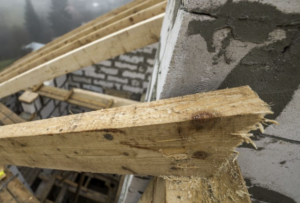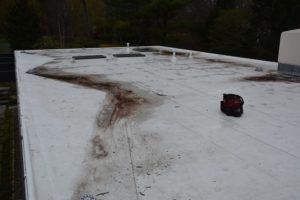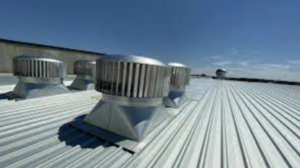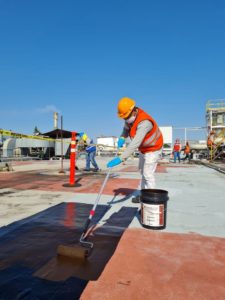
Commercial roofs are a vital investment for businesses, and protecting your commercial roof against damage is essential for ensuring the smooth operation of their daily activities.
However, these roofs are constantly exposed to various threats that can compromise their integrity and lead to costly repairs or replacements.
Understanding and protecting against the common culprits behind commercial roof damage is essential for safeguarding this valuable investment.
From severe weather conditions to poor maintenance practices, numerous factors can contribute to roof damage.
Water infiltration, structural degradation, energy inefficiency, and premature aging are just a few of the consequences that can arise from neglecting the protection and maintenance of commercial roofs.
The purpose of this article is to shed light on the common culprits that cause roof damage in commercial settings and provide insights into how to address and mitigate these issues.
By identifying these culprits and implementing proactive measures, businesses can protect their investments, extend the lifespan of their roofs, and avoid unnecessary expenses.
Throughout this article, we will delve into each culprit in detail, offering valuable information, practical tips, and industry best practices to combat roof damage effectively.
Whether you are a building owner, property manager, or facility maintenance professional, this article will serve as a comprehensive guide to help you protect your commercial roof investment and ensure its long-term performance.
Let’s explore the culprits and arm ourselves with the knowledge to safeguard our roofs from potential damage.
-
Commercial Roof Damage: Lack of Regular Maintenance

Without a doubt, skipping regular maintenance is the #1 way building owners and property managers end up with a severely damaged roofs.
Routine roof inspections and maintenance play a critical role in preserving the health and longevity of commercial roofs.
Regular inspections allow for the early detection of potential issues such as leaks, damaged flashing, or deteriorating materials.
Maintenance activities like cleaning gutters, removing debris, and repairing minor damages can prevent small problems from escalating into major roof failures.
Neglecting regular maintenance can result in a host of common issues that can compromise the integrity of commercial roofs.
Water leaks and moisture intrusion, which lead to mold growth and structural damage, are prevalent consequences.
Additionally, clogged drains, blocked vents, and unaddressed repairs can cause improper water drainage, leading to ponding water and accelerated roof deterioration.
Over time, the lack of maintenance can diminish the roof’s performance, reduce its lifespan, and incur significant repair costs.
It is imperative to prioritize regular roof inspections and maintenance to address these issues proactively and ensure the longevity and reliability of commercial roofs.
-
Commercial Roof Damage: Roof Age and Degradation

The age of a commercial roof can significantly impact its performance and durability.
As roofs age, they become more susceptible to wear and tear from constant exposure to the elements.
Understanding the impact of age on roof performance is crucial for effective maintenance and timely interventions.
Luckily for building owners, there are several obvious signs that indicate roof degradation and deterioration.
These include cracked or missing shingles, curled or blistered membranes, granule loss, and visible signs of aging such as fading or discoloration.
Additionally, water stains on interior walls or ceilings and increased energy costs can also be indicators of roof deterioration.
Prompt identification of these signs allows for proactive measures to address the issues and extend the lifespan of the roof.
-
Commercial Roof Damage: Severe Weather Conditions

Identifying weather events that pose a threat to commercial roofs is crucial for understanding the potential risks and taking appropriate preventive measures.
Severe weather conditions such as high winds, hailstorms, heavy rain, and snow accumulation can cause significant damage to roofs.
High winds can uplift roofing materials, loosen or dislodge shingles, and compromise the roof’s integrity.
Hailstorms can dent or puncture roofs, leading to leaks and structural issues.
Heavy rain can overwhelm drainage systems, causing ponding water and water infiltration.
Snow accumulation can add excessive weight to the roof, potentially causing structural damage or collapse.
The effects of severe weather on commercial roofs can be extensive and costly.
Regular inspections, reinforcement of vulnerable areas, and timely repairs or replacements are essential for mitigating the impact of severe weather events.
By being prepared and taking proactive measures, businesses can protect their commercial roofs from the damaging effects of severe weather conditions.
-
Commercial Roof Damage: Poor Installation and Workmanship

Improper roof installation can have serious consequences for the overall performance and longevity of a commercial roof.
It can lead to various issues, such as poor structural integrity, inadequate waterproofing, and improper sealing of critical areas.
Proper installation techniques, adherence to manufacturer guidelines, and the use of quality materials are essential to ensure a durable and reliable roof.
Signs of subpar workmanship can manifest in different ways and have a direct impact on the roof’s integrity.
These signs may include uneven or improperly aligned roofing materials, improper flashing installation, inconsistent seams, and inadequate ventilation.
These issues can result in water leaks, premature deterioration, and compromised energy efficiency.
Recognizing these signs and addressing them promptly by seeking professional assistance can help mitigate further damage and preserve the roof’s performance.
Investing in reputable contractors and quality workmanship during roof installation is essential to avoid long-term consequences and maintain the functionality and durability of a commercial roof.
-
Commercial Roof Damage: Ponding Water and Poor Drainage

Ponding water, or the accumulation of standing water on flat roofs, can have detrimental effects on the structure and integrity of the roof.
The weight of the water can put excessive stress on the roof, leading to sagging, structural damage, and potential leaks.
Ponding water also provides a breeding ground for algae, mold, and other moisture-related issues.
Inadequate roof drainage systems contribute to the problem of ponding water.
Insufficient or clogged roof drains, gutters, and downspouts prevent proper water flow and drainage.
Without effective drainage, water can accumulate, causing damage over time.
It is crucial to ensure that roof drainage systems are correctly designed, installed, and maintained to prevent ponding water and protect the roof from potential issues associated with inadequate drainage.
Addressing ponding water and improving roof drainage systems are both essential steps in maintaining the health and longevity of commercial roofs.
One of the most efficient ways to check for moisture is with an Infrared Moisture Survey.
This technology is 100% non-invasive and totally futuristic!
Read more about it in our blog about benefits of an infrared roof moisture survey!
-
Lack of Insulation and Energy Inefficiency

Roof insulation plays a crucial role in improving energy efficiency within commercial buildings.
Proper insulation helps regulate indoor temperatures, reducing the need for excessive heating or cooling.
It acts as a thermal barrier, preventing heat transfer through the roof and keeping the interior comfortable.
Insufficient insulation can have several negative effects on roof performance and utility costs.
It can lead to energy inefficiency, with excessive heat gain in warmer months and heat loss during colder periods.
This puts a strain on HVAC systems and increases utility expenses. Additionally, inadequate insulation can result in temperature imbalances, discomfort for occupants, and potential moisture-related issues.
Prioritizing proper roof insulation is essential for enhancing energy efficiency, reducing utility costs, and ensuring occupant comfort.
Conducting energy audits, adding or upgrading insulation materials, and consulting with experts can help address insulation deficiencies and improve the overall performance of commercial roofs.
-
Vegetation and Debris Accumulation

The growth of vegetation and accumulation of debris on commercial roofs can have a significant impact on their condition and performance.
Vegetation, such as moss, algae, or weeds, can infiltrate roof surfaces and compromise their integrity.
Debris, including leaves, branches, and dirt, can block drainage systems, trap moisture, and accelerate roof deterioration.
Common problems caused by vegetation and debris accumulation include water ponding, clogged gutters and downspouts, increased moisture retention, and potential damage to roofing materials.
This can lead to water leaks, mold growth, and even structural issues.
Regular roof cleaning and maintenance, trimming overhanging branches, and implementing preventive measures can help mitigate the problems associated with vegetation and debris accumulation, preserving the functionality and longevity of commercial roofs.
-
Rooftop Foot Traffic and Equipment Damage

Understanding the risks associated with foot traffic on commercial roofs is essential to prevent damage and maintain integrity.
Continuous foot traffic can cause mechanical stress, dislodge roofing materials, and compromise waterproofing layers.
Beyond damaging your roof, walking on a roof in general is hazardous!
In 2019, 880 people died in the U.S. after falling from roofs.
Awareness of these risks is crucial for implementing proper safety measures and minimizing potential harm.
Equipment installations and maintenance activities on commercial roofs can also pose a risk to their structural integrity.
Improper placement or handling of heavy equipment, such as HVAC units or solar panels, can lead to roof punctures, weakened support structures, and leaks.
Implementing strict access protocols, providing sufficient walkways, and using protective measures like roof pads or guards can help mitigate the risks associated with foot traffic and equipment installations.
By being mindful of these risks and taking necessary precautions, businesses can avoid unnecessary roof damage and ensure the longevity of their commercial roofs.
-
Commercial Roof Damage: Improper Roof Ventilation

Proper roof ventilation is crucial for maintaining the health and longevity of commercial roofs.
It allows for the proper exchange of air, reducing heat build-up, preventing moisture accumulation, and regulating indoor temperatures.
Understanding the importance of ventilation is key to ensuring optimal roof performance.
Inadequate roof ventilation can lead to a range of consequences that negatively impact roof performance.
It can result in excessive heat buildup, which can accelerate the deterioration of roofing materials, increase energy costs, and compromise the comfort of occupants.
Inadequate ventilation can also contribute to moisture-related issues, such as condensation, mold growth, and structural damage.
Ensuring proper roof ventilation through the installation of vents, exhaust fans, and balanced air intake systems is essential.
It promotes a healthy and efficient roofing system, prevents damage caused by excessive heat and moisture, and prolongs the lifespan of commercial roofs.
By prioritizing proper roof ventilation, businesses can protect their investment and maintain a comfortable and sustainable indoor environment.
Knowledge is Power!

After reading this blog, we hope that building owners better understand the main offenders when it comes to roof damage.
From lack of regular maintenance to severe weather conditions, poor installation, and inadequate insulation, each culprit poses a significant threat to commercial roof investments.
By recognizing and addressing these issues, businesses can take proactive measures to protect their roofs and avoid costly repairs or premature replacements.
At Instacoat Premium products, we are huge advocates for proactive maintenance, regular inspections, and timely repairs.
By doing these three simple actions, building owners can prevent small issues from escalating into major problems.
Equally, all three of these actions extend the lifespan of commercial roofs and maximize their performance.
The IPP Difference

Another way to extend your roof’s lifespan and keep it protected is with our Silicone Restoration system offers an effective and cost-efficient option.
The IPP Silicone Restoration system is incredibly durable, boasting incredible weather resistance, UV resistance, and excellent resilience to ponding water.
By choosing Instacoat Premium Products, businesses can benefit from advanced restoration technology and avoid the need for costly roof replacements.
Check this out: on average, our customers can expect to pay ⅓ the cost of a total roof replacement by choosing this system!
Learn more about how Instacoat Premium Product’s Silicone Restoration system can protect your commercial roof and prevent costly problems.
Visit https://instacoat.com/our-systems/silicone-roof-restoration-system/ for more information and to request a consultation.
